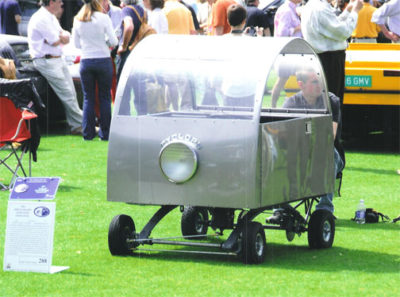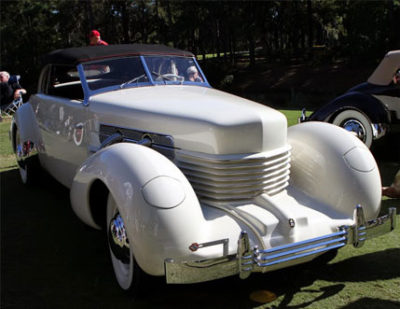Put your eye on this Microcar!
In 1957, Automotive designer Robert Cumberford and cartoon artist/creative visionary Stan Mott created the very first Cyclops II. It was made from a single rectangular piece of metal bent into a “U” shape. Sections were cut out for windshield and backlight. It had a huge Lucas P-100 headlamp centered in the front. The Cyclops was introduced in Road and Track’s March 1957 issue in an article titled ‘Beyond Belief.’ The car was road tested in the September 1957 Road and Track issue and in the last fifty three years has been featured in twenty two articles. Part microcar and part go-kart the Cyclops II has become a fixture of American motoring history.
In 2010, father and son team, Glen and Matt Thomas built a representation of the Cyclops II from scratch. It was a project, which started with the picture of Stan Mott in the original, a three view drawing of the Cyclops II and the road test article with the overall dimensions. Glenn developed a layout using a go-cart drive and steering type system. They built the car in their garage using simple tools such as circular saw, drill press, hand jigsaw and a 110 Mig welder. The rolled panels were accomplished using a homemade roller, which consisted of a pipe sitting on wood. The basic materials are 16-gauge steel and 3/4-inch plywood for the floor.
The Cincinnati Concours d’Elegance Foundation is proud to announce that this faithful reproduction of the iconic Cyclops II has been accepted into the 2014 Ault Park Concours d’Elegance to be held on June 8, 2014.

Check out this 1937 Cord 812 SC
We are pleased to announce that a 1937 Cord 812 SC has been accepted into the 2014 Ault Park Concours on June 8,2014. Some specifics about this beautiful automobile are as follows:
• First supercharged Cord ever shown to the public
• Sold at the International Auto Show in Canada to an architectural engineer, moved from Quebec across Canada to Vancouver, and finally to Washington State.
• Purchased in 1972 in Washington, in poor condition, after collision with an elk.
• Restoration work was started and stopped numerous times due to various family requirements
• Completed in 2011. Won Best Cord, Auburn 2011 and 2012; Most Perfect Cord ever shown 2012; Best in Class, Amelia; Best in Class, Louisville ; Special Judge Award, Glenmore
This sleek classic owes its beautiful lines to designer Gordon Buehrig, who is revered in the auto world as the man most responsible for leading Detroit out of the boxy age of the Model T. His design theory was influenced by Le Corbusier, the French modernist. “That helped me formulate my theory of design,” says Buehrig. “Never do anything without a good reason to do it. A beautiful automobile gets its form from its function.”
With his retirement from the Ford Motor Co. in July 1965, Gordon Buehrig became the last of the great individual classic era designers to leave active participation with an automobile company. He will best be remembered for his stunning 810/812 series front-wheel-drive Cords, but he was also responsible for the appearance of more examples of cars loved and collected by classic enthusiasts than any other designer. Upon his retirement from Ford, Buehrig was asked to teach a course in plastics at the Art Center College of Design in Los Angeles. He taught there five years.
Not only has Buehrig received accolades from nearly every automotive publication in the country, but also he has the distinction of having his 810 Cord recognized by the Museum of Modern Art. In 1951, the museum printed in its catalogue “the originality of the conception and the skill with which its several parts have been realized makes it one of the most powerful designs in the exhibition….” His designs will remain some of the most powerful in automotive history.
